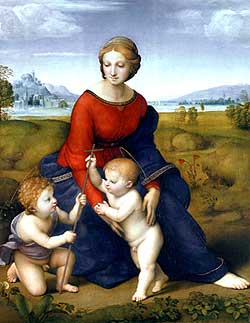Raphael was born in the Duchy of Urbino. He was a master painter and architect of the Italian High Renaissance. Raphael is best known for his Madonnas and for his large figure compositions in the Vatican in Rome. His work is admired for its clarity of form and ease of composition and for its visual achievement of the Neoplatonic ideal of human grandeur. While we may term other works paintings, those of Raphael are living things; the flesh palpitates, the breath comes and goes, every organ lives, life pulsates everywhere.
|
|
 Viewer |
Madonna in the Meadow 1505 or 1506 Wood H 113 cm, W 88.5 cm Within the short span we call the High Renaissance, Raphaels "Madonna in the Meadow is the classic example of a geometric composition based on a triangle or, more exactly, a pyramid. Within this confinement, we find a spirited yet harmonious treatment of the figures. It is full of parallel and contrapuntal relationships. Beyond that, the wide, green landscape, turning blue in the distance, and the softly curving hills combine to unite all the various elements into a balanced whole. The group of figures is at one and the same time ordered and lively, a new and unusual combination of contrasting elements, complete in itself without any extraneous factors. At the time of this painting, Raphael had been influenced greatly by Leonardo da Vinci (30 years his elder) and had avidly followed Leonardos formal experiments with Madonna compositions. Above all, the organic linking of psychic and physical motifs, of action and reaction, create a suspended unity of both formal and programmatic elements. "Only the purest beauty of woman and child can evoke thoughts of the supernatural. After one and a half millennia, art has finally reached the point where the figures alone, without any additions, seem eternal and divine. (Jacob Burckhardt) |
| School of Athens | Granduca | Portrait of a Young Man in Red | Meadow | Duke of Urbino | Madonna and Child with Book | George Fighting the Dragon |
| Renowned Artists Gallery index (61 galleries)
Other Parts of the Permanent Gallery | ||
| Digital Color Winners 2004 and 2005
Digital Color Winners 2002 and 2003 Digital Color Winners 1999, 2000 and 2001 |
Watercolor Painters
Oil Painters Pen and Pencil Artists |
Photographers
Sculptors Authors |